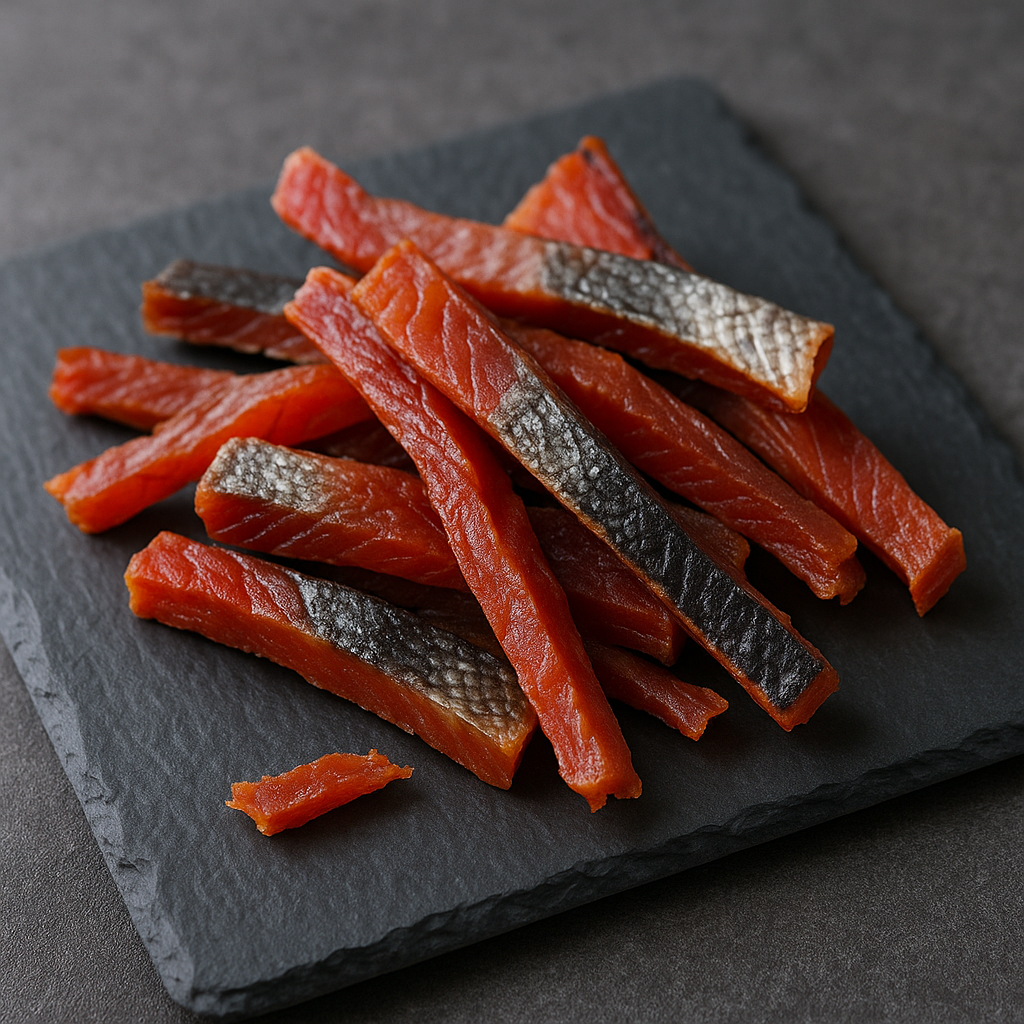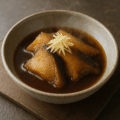鮭とばの特徴
北海道の伝統的な保存食
鮭とばは、北海道を代表する伝統的な保存食で、鮭を細長く切って干したものです。昔から冬の保存食や酒の肴として親しまれてきました。
噛むほどに広がる旨味
硬めに干し上げられた鮭を噛むと、鮭本来の旨味と香ばしさが口いっぱいに広がります。噛めば噛むほど味わいが深まるのが特徴です。
シンプルな製法
塩をして干すだけのシンプルな製法で作られ、余計な調味料を使わないため鮭の旨味をストレートに楽しめます。
鮭とばのレシピ(家庭用簡易版)
材料
- 生鮭 … 1切れ
- 塩 … 適量
作り方
- 鮭を薄く細長く切る。
- 軽く塩をふり、風通しの良い場所で干す(冷蔵庫の乾燥機能を利用しても可)。
- 数日〜1週間ほど乾燥させて完成。
シェフのワンポイントアドバイス
炙って食べると香ばしさが増し、より一層美味しくなります。硬いと感じる場合は少し炙って柔らかくすると食べやすいです。
ジャーキーを作ることが出来る食品乾燥機があるならばより美味しく作ることが出来ます。
鮭とばの栄養価(1人分の目安)
- エネルギー:約150〜200 kcal(50gあたり)
- たんぱく質:20〜25 g
- 脂質:3〜6 g
- 炭水化物:1〜2 g
- ビタミンD・B群(鮭由来)
- EPA・DHA(鮭由来)
- 塩分が多いため食べすぎには注意
高たんぱく・低脂質でありながら、酒の肴や軽食に最適です。
鮭とばの歴史
アイヌの保存食文化
鮭とばは、アイヌ民族が鮭を保存するために干した食文化に由来します。寒冷な気候を活かして長期保存が可能でした。
和人社会への普及
江戸時代以降、北海道の和人社会でも保存食や交易品として広まりました。
現代の鮭とば
現在では北海道を代表する名産品のひとつとして、土産物や酒の肴として全国的に親しまれています。
English Version
Features of Salmon Toba (Dried Salmon Strips)
A Traditional Preserved Food of Hokkaido
Salmon Toba is one of Hokkaido’s representative preserved foods, made by slicing salmon into thin strips and drying them. It has long been enjoyed as a preserved food for winter and as a snack with sake.
Flavor That Deepens as You Chew
When chewing the firm dried salmon, its natural umami and roasted aroma spread through the mouth. The more you chew, the deeper the flavor becomes.
Simple Preparation
Made simply by salting and drying, without unnecessary seasonings, it allows you to fully enjoy the pure flavor of salmon.
Recipe (Simple Home Version)
Ingredients
- Fresh salmon … 1 fillet
- Salt … to taste
Instructions
- Cut the salmon into thin, long strips.
- Lightly sprinkle with salt and dry in a well-ventilated place (or use the drying function of a refrigerator).
- Dry for several days to a week until ready.
Chef’s Tip
Grilling the salmon toba before eating enhances its aroma and makes it even more delicious. If it feels too hard, lightly grill it to soften. Using a food dehydrator designed for making jerky will result in an even tastier product.
Nutritional Value (per 50g serving, approx.)
- Calories: 150–200 kcal
- Protein: 20–25 g
- Fat: 3–6 g
- Carbohydrates: 1–2 g
- Vitamin D & B group (from salmon)
- EPA & DHA (from salmon)
- High salt content — moderation is recommended
High in protein, low in fat, and perfect as a snack or accompaniment to sake.
Historical Background
Ainu Preserved Food Culture
Salmon Toba originates from the food culture of the Ainu people, who preserved salmon by drying it. The cold climate made long-term preservation possible.
Spread to Wajin Society
From the Edo period onward, it spread among the Japanese settlers in Hokkaido as a preserved food and trade item.
Modern Salmon Toba
Today, it is recognized as one of Hokkaido’s specialty products and is widely enjoyed across Japan as a souvenir and a popular snack with sake.



何でも質問してください!